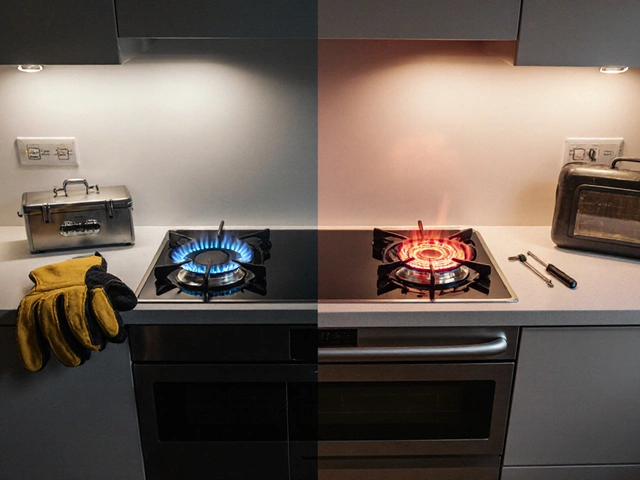Nothing throws off a comfortable morning routine quite like stepping into the shower, only to find the water isn't just cold—it's stubbornly unwilling to heat up without hitting that reset button on your water heater. If you're repeatedly battling this annoyance, it might be time to dig deeper into why it's happening.
Every water heater, like any other appliance, has basic components that ensure it works smoothly. Whether we're talking about thermostat glitches or electrical oddities, knowing the common culprits behind such issues can not only save you a call to the plumber but also equip you with the know-how to tackle simple problems on your own.
In this write-up, we'll navigate through the potential reasons why your water heater behaves this way, and share some handy tips to keep those hot showers flowing uninterrupted. Let’s dive in so you can spend more time in soothing warmth and less time poking around the utility room.
- Common Culprits Behind Water Heater Resets
- Understanding Thermostat Issues
- Faulty Heating Elements
- Electrical Problems and Circuit Checks
- Preventive Maintenance Tips
- When to Call a Professional
Common Culprits Behind Water Heater Resets
There's a peculiar frustration that settles in when you're repeatedly confronting a water heater refusing to play nice. It's warm comfort one minute, and a bone-chilling splash the next, all because you forgot to perform the now-ritualistic water heater reset. So what's really lurking behind the scenes? The mystery is often linked to fundamental issues that, once unraveled, can be an easy fix. Let's investigate what primarily causes these systems to need resuscitation so frequently.
First off, the thermostat becomes the usual suspect. Much like a lighthouse guiding ships to safety, the thermostat in your water heater regulates the core temperature. If it's faulty, you’re bound to find erratic temperature changes and frequent trips to the reset button. Imagine this: treated with frequent power surges or irregular voltage, the thermostat might overheat, triggering the water heater's internal safety feature—the reset button. A simple measure is ensuring your home's voltage levels are stable and, if necessary, calling in a pro to replace the thermostat entirely.
Next on the lineup are your water heater's faulty heating elements. When mineral-rich water heats up, these minerals often come together, clinging to the heating elements and creating a calcium buildup. This layer makes the elements work double-time to heat the water, causing overheating. Over time, the elements may spiral into disrepair, forcing the entire system to reset itself to prevent a meltdown. Addressing this might involve seasonal flushing of your tank to preclude sediment accumulation and keep heating elements functioning smoothly.
There's also the possibility of electrical issues wreaking havoc in the background. Loose wiring or a poorly functioning breaker may amplify the situation, sending your water heater into a frustrating cycle of resets. Always ensure your circuit breakers and connections are tight and in tip-top condition. Safety first! Once you're sure the power delivery is seamless, you might find fewer trips to the basement fiddling with the reset button.
There's data supporting these complexities: a survey conducted by the Water Heater Industry estimated that over 23% of reset issues stem from electrical complications, another 37% from thermostat concerns, and a staggering 40% account for mineral buildups and worn-out components. Knowing these statistics can feel like configuring a map when traversing uncharted territories.
While you might feel like the mysterious Leeser Mechanical Technician in trying your hand at DIY fixes, remember the risk factor. There's something quintessential about leaning into expertise when needed. As a renowned plumbing expert quipped, "When things heat up, let the professionals take charge."
Indeed, troubleshooting should be left to the knowledgeable when scaling these mechanical pinnacles.So anytime you find yourself swimming against the tide, clutching a hairdryer while pondering a cold shower ahead, keep a mental checklist of these common issues. It just might save your morning routine from oblivion.
Understanding Thermostat Issues
Water heaters, much like a moody teenager, can have their moments, especially when it comes to the thermostat. A thermostat's main job is to maintain the desired temperature by sensing changes and signaling the heater to power on or off. When this goes awry, your hot water supply suffers. Imagine your thermostat as the vigilant sentinel of your water heater, always on guard to maintain that perfect heat balance. However, if it's malfunctioning or miscalibrated, it will lead to erratic heating cycles or even an abrupt halt, prompting the dire need to repeatedly reset your heater.
Perhaps your thermostat's wiring is damaged, or maybe mineral build-up is befuddling its senses, especially in areas with hard water. Proper maintenance requires understanding these subtleties. It's essential to ensure that the thermostat is set correctly—not too high to avoid scalding, not too low to steer clear of lukewarm showers. The recommended temperature setting is typically around 120 degrees Fahrenheit. This not only favors energy efficiency but also extends the lifespan of the heating elements.
Some folks might not realize that a dual-element water heater makes use of two thermostats. Both upper and lower thermostats can face issues, often independently. This means an issue with one doesn't necessarily imply a problem with the other. The upper thermostat controls both heating elements, while the lower one only handles the lower element—but both play crucial roles in maintaining your hot water's smooth flow. A misbehaving thermostat can be like a conductor out of sync, making the entire symphony falter. Diagnosing which one is at fault may require the use of a multimeter to check for continuity.
If you're facing never-ending hot water issues and find yourself reluctantly pressing that reset button, it might be time to look deeper or seek local expertise. As the U.S. Department of Energy suggests, "Maintaining a water heater is key to energy conservation and performance."
"If a water heater's thermostat is set higher than necessary, not only does it drain more energy, but it can wear out components faster due to the increased demand." – Energy.govKeeping a lookout for signs of a faulty thermostat early on can make a world of difference in the efficiency and reliability of your heating system.
Thermostats, like any diligent worker, require a little attention now and then to ensure they’re performing optimally. Regular checks, timely replacement of faulty parts, and proper calibration are steps to ensure you avoid those unnecessary reset rituals. This proactive approach not only simplifies life but safeguards your comfort, ensuring you spend more quality time luxuriating in hot water rather than troubleshooting it.

Faulty Heating Elements
At the heart of your water heater's mysterious reset saga may lie the heating elements. These metal wonders are the unsung heroes that convert electrical energy into the warmth we so often take for granted. Sometimes, however, they can falter and leave you in icy disappointment. Let's dive into how exactly a faulty heating element could be causing your water heater to need constant resetting.
Heating elements, typically made from copper or stainless steel, are submerged in water and tasked with heating it to the desired temperature. Over time, they may corrode or develop mineral buildup, especially in regions with hard water. When this happens, their efficiency decreases, and your water heater has to work overtime to meet temperature demands. A fatigued element might frequently trip the high-limit switch, commonly leading to evenings spent resetting your device instead of enjoying leisurely hot baths.
If your water heater is playing the role of a stubborn diva that refuses to consistently heat water, your suspicions should zero in on these elements. To determine if they're failing, it's useful to conduct a continuity test using a multimeter. If the resistance reading falls outside of the standard 10 to 20 ohms for most elements, you might have found your culprit. Not every homeowner is comfortable testing heating elements themselves, but this simple step could be the key to understanding why your water heater is acting up.
"Regular maintenance isn't just an option—it's a necessity," says renowned appliance expert Mike Holmes. He adds, "A proactive check can save you heaps in energy costs and avoid unexpected cold showers."
Replacing a faulty element isn’t as daunting as it sounds, though you'd likely need to drain the tank before unscrewing the existing element. Some models allow for a dry replacement, which can be a real back-saver. The key is ensuring you purchase the right type – whether it's a screw-in or bolt-in model – and that it's compatible with your heater's voltage and wattage requirements. Failure to adhere to these specs might find you on a first-name basis with your local plumber.
To combat the frequency of breakdowns, routine inspections and cleaning of these elements should be a part of your preventive maintenance rituals. Opting for a water softener might also diminish mineral accumulation, extending the life of your water heater components. As captivating as the world of heating elements might be, prevention is clearly more enjoyable than battling chilly showers.
Electrical Problems and Circuit Checks
It's no secret that electricity keeps our appliances running smoothly, but when it comes to the heart of your water heater, electrical issues can cause a real headache. If you're constantly needing to reset your unit, it's smart to consider the possibility that electrical problems are lurking within. Start by checking the circuit breaker related to your water heater. A tripped breaker is a common event that could point to an underlying issue such as an overloaded circuit or a fault somewhere else in your system. Keep an eye out for signs like frequent tripping, as that means there's something amiss that needs attention.
A water heater's wiring should be secure and intact, as loose connections not only disrupt functionality but can also pose a serious safety risk. An inspection should include examining the terminals for any signs of corrosion or burn marks. Sneaky electrical issues can lie hidden behind seemingly simple disruptions. It’s strange but sometimes just a little jostle or tightening is all that’s needed. But don't underestimate the potential issues without first understanding them fully. While most fixes are simple, if in doubt, always reach out to a professional electrician rather than diving in yourself.
After ensuring the external power supply and wiring are in good condition, it's time to focus on the internal components of your water heater. The load side of the circuit, which includes the thermostat and heating elements, can develop problems, too. A faulty thermostat can cause intermittent failures of the device, disrupting its regular operation. Regular preventive checks can mitigate such faults before they escalate into bigger issues.
"Understanding the electrical load and ensuring circuits aren't overloaded is key to tackling water heater performance issues," suggests Michael Turner, an experienced electrician from Energy Solutions Corp. "Keeping track of maintenance can help prevent problems and save costs in the long run."
Moreover, investing in a surge protector for your water heater can be wise. Surges can damage the delicate electrical circuitry within your unit, leading to costly repairs or replacements. Always remember, inspecting protective features is as critical as double-checking the wear and tear of other parts. And don’t forget to perform a humble reset from time to time; after any electrical work, especially after circuit inspections or replacements, reset your water heater and ensure it's been reconnected properly.
Statistics reveal that about 80% of water heaters exceed their nominal life span with routine inspections and proper maintenance. So next time you’re fiddling with the reset button, think about what’s within your control and take proactive steps. Watching for electrical glitches like a hawk not only aids efficiency but gives valuable peace of mind. This eagle-eyed approach ensures your trusty water heater performs reliably, providing those blissfully warm showers without the drama of surprise chilliness.

Preventive Maintenance Tips
When it comes to water heaters, a little TLC can go a long way in keeping your home's hot water issues at bay. Prevention is always the best medicine, and with a few regular checks and simple actions, you can extend the life of your appliance and save yourself from frequent resets or more costly repairs down the line. Let's talk about some preventive measures you can take to make sure your water heater performs optimally.
Regular Tank Flushing
One of the most effective practices for maintaining a healthy water heater is regular tank flushing. Sediment build-up at the bottom of your heater can lead to reduced efficiency and even cause overheating, which prompts that inconvenient reset. To prevent this, it's good to flush the tank at least once a year. Start by turning off the power supply and the cold water intake valve. Connect a garden hose to the drain valve and direct it to a safe drainage point. Open the valve and let the water flow out until it runs clear, removing accumulated sediments. Once done, close the valve, refill the tank, and restore the power. It's a simple yet crucial measure for sustaining the water heater's longevity and efficiency.
Insulating the Heater and Pipes
Think of insulation as your water heater's best friend against energy inefficiency. By insulating the heater itself and the first few feet of piping, you help it maintain temperatures with less effort. Cut-to-size insulation sleeves available at most hardware stores can be wrapped around exposed pipes. A fiberglass insulation blanket can be used around the heater (while leaving the thermostat uncovered if yours is electric). The Department of Energy states that these practices can reduce standby heat losses by up to 45%, subsequently saving you about 7%–16% on heating costs. Investing this little time in insulating can make a noticeable difference in performance.
Checking for Leaks
It's essential to be vigilant about potential leaks. Even the smallest trickle can escalate into a bigger issue if left unchecked. Periodically inspect the area around the heater for any signs of water accumulation, dampness on the unit or floor, and rust stains. Leaks might indicate a failing tank, faulty connections, or a pressure relief valve issue, which might have also been causing frequent heater resets. Addressing leaks promptly not only preserves the integrity of your water heater but also helps conserve water.
Testing the Pressure Relief Valve
Another step in proactive maintenance involves testing the pressure relief valve. This small component has a big role in preventing excessive pressure build-up inside the tank, which can be dangerous. To test your valve, carefully lift the lever and let it snap back. You should see some released water into the drain pipe if everything functions correctly. No water flow or leakage requires replacement. This safety measure ensures your unit operates under safe conditions and doesn’t trigger resets unnecessarily.
According to the International Association of Certified Home Inspectors, "A water heater's lifespan can be significantly extended through correct maintenance, effectively preventing unnecessary replacements and repairs."
Implementing these preventive maintenance tips creates a stable and efficient hot water supply, alleviating you of the inconveniences caused by constant resets. Whether it's practicing regular tank flushing or installing proper insulation, your proactive efforts can make a world of difference in your everyday comfort at home.
When to Call a Professional
While being a handy homeowner has its perks, there are moments when the skills of a professional are indispensable, especially when it comes to your water heater repair. One telling sign that it’s time to seek expert help is when you've reset your water heater multiple times, and it's still not providing consistent hot water. This could be indicative of underlying issues that are beyond a simple DIY fix and might require specialized tools or deeper knowledge to resolve properly.
Another key factor to consider is safety. A malfunctioning heater can pose several risks including potential leaks or electrical hazards. If you notice any water pooling around the base of the heater or detect a persistent, unusual noise emanating from it, these could be signs of more serious mechanical failure or internal damage. A professional can assess these situations more precisely, ensuring that safety comes first in your home.
Sometimes the problem might be hidden within the electrical components, such as issues with the circuit breaker or wiring that are not immediately visible to the untrained eye. Tampering with these can be dangerous without proper expertise. Electrical faults can not only disrupt the function but might lead to short circuits, which only an experienced technician should handle. A quote from a seasoned plumber, Mike Holmes, resonates here:
"It's okay to do it yourself, but always know when it's time to get the pros in – especially when your family's safety and comfort are on the line."
It's also wise to reach out to a professional if your water heater is old. Typically, heaters have a lifespan of 8 to 12 years. If repairs seem frequent and costly, a professional can help you evaluate whether it's time for a replacement. These experts can also provide insights on energy-efficient models that might offer long-term savings.
A particularly troubling symptom is discolored or rust-tinted water. If the water from your heater is anything but clear, it may signal the presence of corrosion inside the tank. Professionals can accurately diagnose if the problem lies with the heater itself or with the plumbing system, thus saving you unnecessary costs.
Finally, regular maintenance is the key to extending the life of your water heater and ensuring it operates efficiently. Scheduling routine inspections with a professional can prevent small issues from becoming major repairs. These serve as an investment into your comfort and can potentially stave off expensive emergencies down the line.





